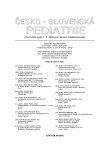-
Medical journals
- Career
Long-term Follow-up after Liver Resection in Children
Authors: O. Petrů 1; M. Rygl 1; J. Šnajdauf 1; E. Čumlivská 2; J. Mališ 3; L. Tomášek 4
Authors‘ workplace: Klinika dětské chirurgie 2. LF UK a FN Motol, subkatedra dětské chirurgie IPVZ, Praha přednosta prof. MUDr. J. Šnajdauf, DrSc. 1; Klinika zobrazovacích metod 2. LF UK a FN Motol, Praha přednosta prof. MUDr. J. Neuwirth, CSc. 2; Klinika dětské hematologie a onkologie 2. LF UK a FN Motol, Praha přednosta prof. MUDr. J. Starý, DrSc. 3; Státní ústav radiační ochrany, Praha ředitel ing. R. Filgas 4
Published in: Čes-slov Pediat 2005; 60 (5): 264-273.
Category: Original Papers
Overview
Objective:
To evaluate a general health of children after liver resection in a long-term horizon since the operation. To evaluate their nutritional status, growth and further development. To evaluate the ability of regeneration and continuous growth of liver parenchyma. To further evaluate liver function, to evaluate liver functions in relation to the extent of resection, to oncological therapy and to demonstrate independence of regeneration of liver parenchyma on the application of chemotherapy; to evaluate cosmetic results in different periods of time after the surgery.Material:
A group of 30 children, who underwent liver resection in the period of 1991–2002.Methods:
The evaluation of present nutritional condition and assessment of evolution of nutritional parameters by standard methods of measurement (weight, height, BMI, weight/height, skinfold). The examination by computing tomography (CT) with special reference to liver parenchyma, presence of regeneration nodes and, if any, relapse of the disease were observed. The determination of regenerating capacity of the liver in individual periods of time according to the index of liver regeneration (ratio of laterolateral (LL) distance of residual liver parenchyma and the width of body trunk (T) at the given level) and its evolution and the determination of growth continuity in a long period of time. The execution of biochemical, serological and hemocoagulation analysis of blood samples were made for the determination of functional condition of liver parenchyma. The evaluation of long-term cosmetic results after the surgery and their comparison in groups was made according to type of suture.
The determination of correlations and statistical significance of individual observed parameters in relation to the time from the operation, basic diagnosis (malignant, benign) or the application of chemotherapy (CHT) and the extent of resection.Results:
At the present time 39 patients still live from those who underwent liver resection during 1991–2002. Thirty patients (18 boys, 12 girls), whose parents agreed with their participation in this study, were examined. The age of subjects in this group at the time of operation was in the range of 0.5–14.5 years. The time period from the operation is from 1.5 to 13 years and the present age of the patients in 2–23 years. The time since the end of chemotherapy is in the range of 2–13 years.
The comparison of average percentiles of individual anthropometric parameters of the observed group with general population did not reveal statistically significant differences. The distribution of patients into percentile ranges according to weight and height corresponded to distribution of general population. The comparison of groups according the extent of resection, type of basic disease and the time period from the surgery mostly did not reveal significant differences.
A favorable development of the nutritional condition in the long period of time after the operation was detected in 87% of the patients. Chemotherapy did not influence nutritional development.
The values of dimensions obtained from CT documentation indicate that the index of liver regeneration in postoperative period is growing at a maximum extent in the first years after the resection. In the following years the liver parenchyma grows in relation to the growing width of the body trunk. The measurements performed confirm a rapid volume regeneration of liver parenchyma and the capacity of long-term growth after liver resection, even after the application of oncological treatment with chemotherapy.
The proteosynthetic functions of the liver has been excellent in all patients. The metabolic and excretory functions of the liver were within normal levels in more than 70% of patients, while the others experienced only a mild elevation of individual liver tests (JT). None of the patients was found to suffer from any complex of liver function disorder.
The cosmetic result (the appearance of the postoperative scar) of evaluated as excellent in 46.6% patients of the whole group, satisfactory in 26.7% of the patients and unsatisfactory in 26.7% of the patients. The cosmetic results significantly improved (from 1994) after the introduction of intradermal plastic stitch (an excellent effect in 73.8%, satisfactory in 15.7%, unsatisfactory only in 10.5% of patients).Key words:
liver resection in children, liver regeneration, nutritional status, liver function, operation wound
Labels
Neonatology Paediatrics General practitioner for children and adolescents
Article was published inCzech-Slovak Pediatrics

2005 Issue 5-
All articles in this issue
- Maternal Phenylketonuria (PKU) in the Moravian Region
- A Sudden Cardiac Death at the Child Age
- Long-term Follow-up after Liver Resection in Children
- Long-term Changes in the Growth of Czech Children Population
- Asthma in Children
- Failure of Vaccination against Haemophilus Influenzae Type b
- The Possibilities of Establishing Risk in Development of Premature Atherosclerosis by Imaging Methods at the Child Age
- Lung Sequestration
- Pneumococcal Infection in Children and Their Prevention
- Czech-Slovak Pediatrics
- Journal archive
- Current issue
- Online only
- About the journal
Most read in this issue- Lung Sequestration
- Maternal Phenylketonuria (PKU) in the Moravian Region
- Failure of Vaccination against Haemophilus Influenzae Type b
- A Sudden Cardiac Death at the Child Age
Login#ADS_BOTTOM_SCRIPTS#Forgotten passwordEnter the email address that you registered with. We will send you instructions on how to set a new password.
- Career

